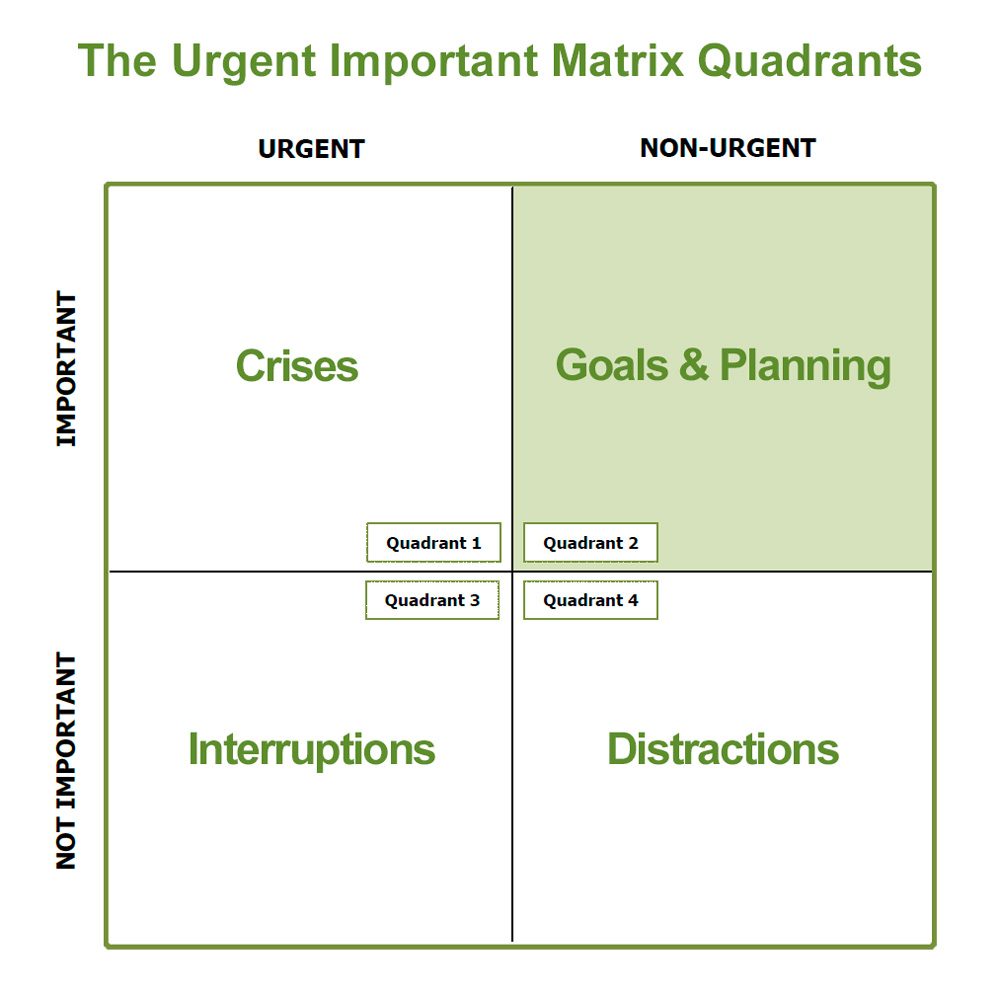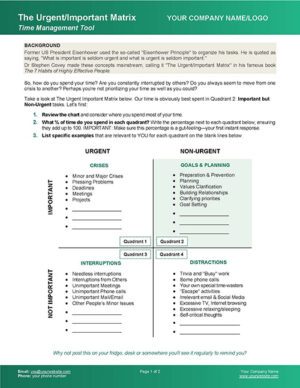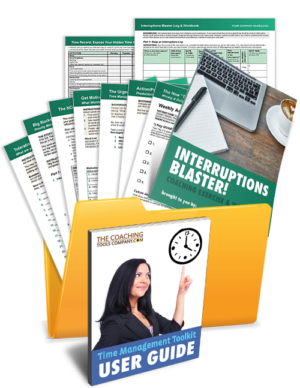Originally Posted on The Coaching Tools Company as How to Use The Urgent Important Matrix in a Coaching Workshop (or Webinar) in 7 Steps
The Urgent Important Matrix is a simple yet powerful resource to help your clients manage their time more effectively. And it’s also a compelling and helpful tool to share in a workshop or seminar—because it teaches people a powerful concept they can APPLY in their lives right away.
Your job as a workshop leader (once you’ve shared the concept), is to coach people so they can make meaning and learn: What does this mean for me? Where could I do better? Where do I get in my own way? What actions could I move forwards with?
How Long to Make this Workshop or Webinar?
Yes, you can whiz through this time management tool in a 45-60 minute “Lunch and Learn”. But you’ll need to know your material, minimise the group activities (I recommend all of Section 3 and just Section 5c), cover the bare minimum and keep people moving. This would then be a time management introduction or primer to show people what’s possible!
But to really do this excellent time management tool justice, I would allow 2-3 hours. That way you’ll have plenty of time to introduce yourself, use an icebreaker (why not try our 21 Workshop Icebreakers and Exercises eBook) AND have an “offer” for your participants to sign up for something else with you at the end of your session.
Quick Urgent-Important Matrix Overview
So, using a simple grid, the Urgent-Important Matrix defines tasks according to their importance and urgency:
- Quadrant 1: Crises – URGENT and IMPORTANT
- Quadrant 2: Goals and Planning – NON-URGENT and IMPORTANT
- Quadrant 3: Interruptions – URGENT and NOT IMPORTANT
- Quadrant 4: Distractions – NOT URGENT and NOT IMPORTANT
The key idea is that people will spend LESS time in Crises if they spend MORE time in Goals and Planning AND LESS time in Interruptions and Distractions. And we’ll go into this a little more below.
If you are unfamiliar with The Urgent Important Matrix, I recommend reading this article about The Urgent Important Matrix—What it is and How To Use it here >>

Get Your Urgent-Important Matrix Exercise & Coaching Tool here
-
 Individual Tool
Individual ToolUrgent Important Matrix Template and Worksheet
Are your clients feeling swamped? Running from one crisis to the next? This fabulous matrix worksheet will revolutionize how clients spend their time! Read More…
Also Available In: Productivity & Time Management Toolkit
Add to cart
$9.95
Here’s How to Run Your Urgent-Important Matrix Workshop!
STEP 1) Workshop INTRO (5-10 mins)
If you have time, it can be fun to start people off with an icebreaker so they begin to gel as a group and will feel more comfortable with each other for the group exercises.
Then briefly introduce yourself and your business. What do you do? Why do you do it? What’s important to you? I particularly recommend sharing a personal story/anecdote related to time management and how the Urgent-Important Matrix helped you!
Now you’re ready to share the Urgent-Important Matrix.
STEP 2) UNDERSTAND the Urgent-Important Matrix (10-15 mins)
2a) Start with an overview
- Begin by giving your workshop attendees a high level overview of the Urgent-Important Matrix so they understand the concept.
- This is ideally done by drawing a grid using a whiteboard or flip-chart, or sharing a slide.
- Explain the quadrants at a high level, sharing the distinctions between Urgent and Non-Urgent, and Important and Not Important.
TIP: You’ll be writing things in the grid next, so make sure you draw a big enough grid!

2b) Go deeper into the Urgent-Important Matrix
Next, draw out your attendees by going through each quadrant and asking them to share examples of activities they think fit into each quadrant.
At the moment this is an “intellectual” exercise. So whilst your attendees might bring up their own activities, it’s good just to get them to share anything they think of—or things they see other people doing. If necessary, start them off with a couple of suggestions of your own (see the examples in the grey box below).
Then, as people shout out their ideas, write them on the slide, whiteboard or flip-chart where you drew the initial grid.
Example Urgent-Important Matrix Quadrant Activities
|
STEP 3) MAKE IT PERSONAL (15-45 mins)
3a) What are your UNIQUE ACTIVITIES in each quadrant?
Now we’re going to make it personal by asking people to identify their own unique activities in each quadrant.
Give participants a printed Urgent-Important Matrix tool and ask them to fill out specific examples that are unique to them in each quadrant. If it’s a webinar get your attendees to draw out the quadrants on a piece of paper, and then fill this out.
- Best Option: First do a short group exercise!
- Get your attendees into groups of 3-4 (or put in breakout rooms) to discuss each quadrant in turn, and share specific, personal examples with each other.
- If you have time, ask each group to come back to the room or main webinar and share common themes from their group exercise.
- TIP: This takes a little longer—but people learn so much more from sharing with each other and hearing other people’s (usually similar) issues!
- Finally, ask people to fill out their own unique activities onto the Urgent-Important Matrix hand-drawn grid or tool provided.
- If short of time: Your attendees can go straight to writing out their individual activities, rather than exploring in groups first.
TIP: Make sure everyone has at least one personal example in EACH quadrant.
3b) HOW MUCH TIME do they spend in each quadrant?
Next ask your attendees to estimate the percent of time they spend in each quadrant, and write that number down against each quadrant.
TIP: Remind them to go with their gut-feeling—we want their first, instant response, not for them to adjust the numbers so they sound better!
Here’s the Goal of the Urgent-Important Matrix:
|
3c) Now coach people to some PERSONAL LEARNINGS around how they spend their time
So the percentage of time spent in each quadrant and the personal activities your attendees have assigned now gives them an opportunity to review how:
- Their time management (or lack of it) impacts how they feel and
- How they could spend their time more effectively.
Now coach your audience, asking questions like:
- Which quadrant do they spend MOST time in? How does that feel? Why do they think that is?
Detailed Coaching Notes with Example Questions to Ask
|
STEP 4) Deeper LEARNING (for longer workshops—15-30 mins)
4a) So, WHAT’S GETTING IN THE WAY of better time management?
- Ask, “What’s getting in the way of you managing your time better—specifically?” Give people a few examples (see grey box below) and let them ponder for a moment.
- Then, put people into groups of 3-4 (or breakouts if it’s a webinar) to discuss the underlying reasons why each of them spends the time they do in each of the quadrants.
- The purpose is not to have a ‘complaining session’ but trying to pinpoint the exact causes.
- If you break people into groups it’s really valuable to allow time for each group to present their findings back to the overall group.
OPTION: This can also be done as a solo exercise or an entire group exercise (where you facilitate everyone, and write on the board/slide etc). But if you have time I recommend small groups as people love the opportunity to learn from peers, and benefit from hearing from others.
| Examples could include a boss who keeps piling on new tasks without clarifying priorities. Are the systems and processes they use leading to unnecessary extra work? Is their work routine and boring so they use interruptions and distractions to break up the day? If you’re dealing with people-managers, are interruptions caused by employees? Are the employees attempting to clarify their tasks or priorities? Is someone’s desk next to the water cooler so people keep chatting to them? What about email, cellphones, fear of planning? Make sure they are specific and can pin the issue down before identifying solutions. |
4b) SELF-AWARENESS
Now it’s time for your attendees to do some personal introspection.
- Where are THEY the cause of their issues? Ask, “Where do you sabotage yourself?” and help them to take some ownership.
TIP: This is best done as a solo exercise so people can ponder and go deep. But if there is a high level of trust between the attendees and you have lots of time, then by all means put people into groups of 2-3 to explore!
| Examples of self-sabotage include do they run effective meetings with an agenda, or is time wasted going off-topic? Do they have trouble saying “No” and end up saying “Yes” to more than they can handle? Do they enjoy saying “Yes” and feeling ‘heroic’ rather than getting their own work done? Do they avoid prioritising and planning? Do they lack clarity, discipline or focus—yet don’t do anything to address this? Are they bored and uninspired in their life, and daydream the day away? Do they dislike (or not know how to do) some parts of their job, so they distract themselves constantly with email? |
STEP 5) TAKE ACTION (5-15 mins)
5a) MOTIVATION: How would they like to spend their time differently? What’s in it for them?
You may find people like or get the idea of improving their time management—but they won’t make the necessary changes until they’re truly motivated. So let’s help them discover how it will benefit them!
- Ask your group, “How would your life be different if you managed your time more effectively?”
- Let people in the group share their ideas so everyone can hear and be inspired.
- As people shout them out, write them on a slide, whiteboard or flip-chart.
OPTION: If you have lots of time, put people into groups of 3-4 to discuss their answers, and then come back to the room and share their ideas!
| Examples could be they’d like a promotion, pay-rise, some training, more time with the kids, a new job or career or perhaps simply doing less of what they loathe and more of what they love? |
5b) BRAINSTORM ideas: What could they do?
It’s time to do some brainstorming.
- Get people either solo, or if you can into groups of 3-4, and ask them to work together to EACH come up with 3-5 possible actions to improve their time management.
- Again, if you break people into groups it’s really valuable to allow time for each group to present their findings back to the overall group.
- TIP: Let people know they don’t have to action all of the ideas—this is just a brainstorming exercise to come up with as many ideas as possible.
| Examples could be to request some training or find a book on the subject, set time aside every morning or evening to plan their day or perhaps they could set up a regular meeting with their team or boss to clarify priorities. Maybe they could start work earlier when it’s quiet and focus on getting the big tasks done. Or maybe they need to feel they’re adding value or having fun—even if this is in their personal lives rather than their work lives. |
5c) COMMITMENT: What will they commit to doing?
It’s time to ask your attendees for 1-3 specific actions they will commit to.
- Let people know they’ve heard a lot of ideas—and they also probably have their own idea/s of a helpful change they could make.
- Now ask people to choose at least 1, but up to 3, actions to take away and work on.
- Ask them to make sure they have one action they can implement right away—or in the next day or so.
- Ask questions like: What is the KEY action that will make the difference to their effectiveness?
- TIP: Let them know to only pick actions they’re 100% sure they feel inspired to complete. If necessary they can make the action smaller or easier—until they can commit one hundred percent.
- Next get them to WRITE the action down. If you like, ask them sign and date it for extra commitment!
- Once everyone has at least one action, ask them to share their action/s—either with the group or with the person next to them. This will depend on the time you have left and the size of the group.
STEP 6) A Powerful Finale (5 mins)
As a wrap-up it’s always helpful and interesting (to yourself and the other attendees) to ask people to share with the group:
- What was your biggest win from this session? What helped you the most?
OPTION: Give people a Workshop Feedback Form to complete. We have a Free Workshop Feedback form here >>
STEP 7) Lastly, remember to promote you! (5 mins)
What kind of client do you love to work with? How do you help your clients? Share what you do and how you can help with an offer AND tie it into the workshop you’ve just shared with them.
Would people like some help managing their time better—at work, for work-life balance? Do they know what they need to do, but need help with accountability and committing to their actions? Perhaps they’d like some help creating a healthy lifestyle or working on their values.
Whatever you offer, be sure you are clear and confident.
TIP: Make sure you have business cards and promotional materials to handout and giveaway (and if they have a time-management focus so much the better). Now you’re good to go—enjoy your workshop and webinar!
Wrap-up
So, I hope you’ve enjoyed this article on how to use The Urgent-Important Matrix in a workshop or webinar!
You can make this workshop as long as you like (simply add more group activities and reflective questions), but I would recommend an absolute minimum of 45 minutes and no more than 3 hours (a morning, afternoon or evening).
And remember that:
If an audience only listens, they take away 12% of your content. By making it more visual, you can increase audience comprehension and remembrance to 26%. But when you actually get them involved and responding, their understanding and ‘take away’ goes up to 51%. Mark Lavergne
Get Your Urgent-Important Matrix Exercise & Coaching Tool here:
-
 Individual Tool
Individual ToolUrgent Important Matrix Template and Worksheet
Are your clients feeling swamped? Running from one crisis to the next? This fabulous matrix worksheet will revolutionize how clients spend their time! Read More…
Also Available In: Productivity & Time Management Toolkit
Add to cart
$9.95
Which is also available in the Time Management Toolkit here:
Add to cart
$59.00
If you liked this article on running a workshop and time management you may also like:
- The Key to Manage Interruptions Like a Pro with 3 Specific Ideas, 12 Strategies & More!
- Life Coaching Workshop Ideas: 7 Coaching Tools and Exercises to Grow Your Audience!
- How to Run an Awesome Workshop Using the Wheel of Life (in Under an Hour)!
- My Favourite Workshop Icebreaker!










